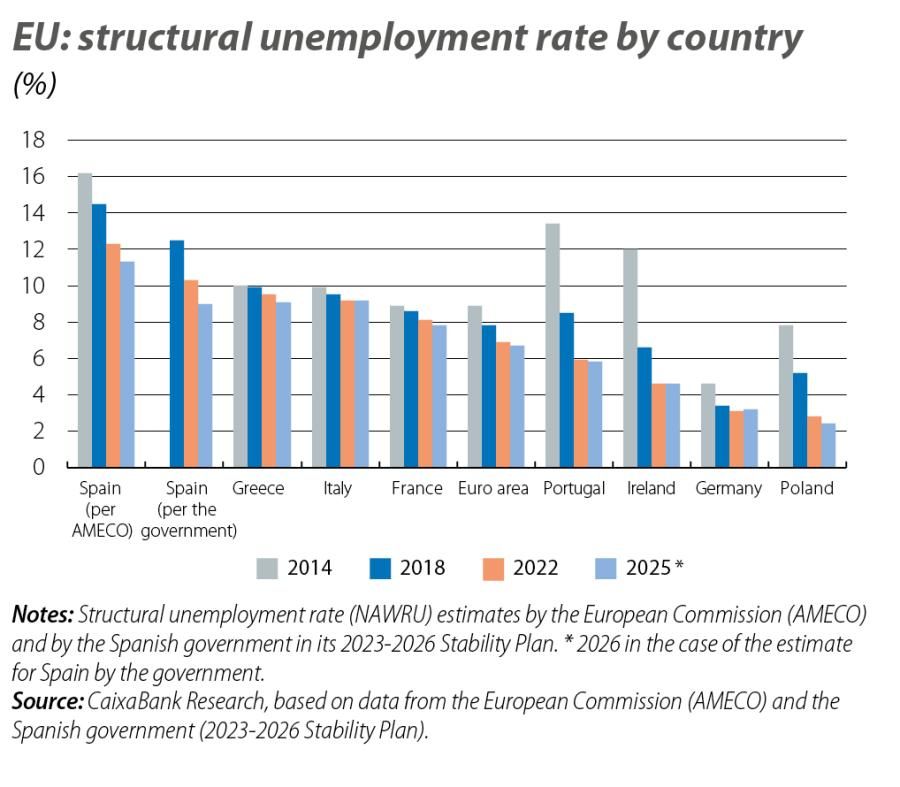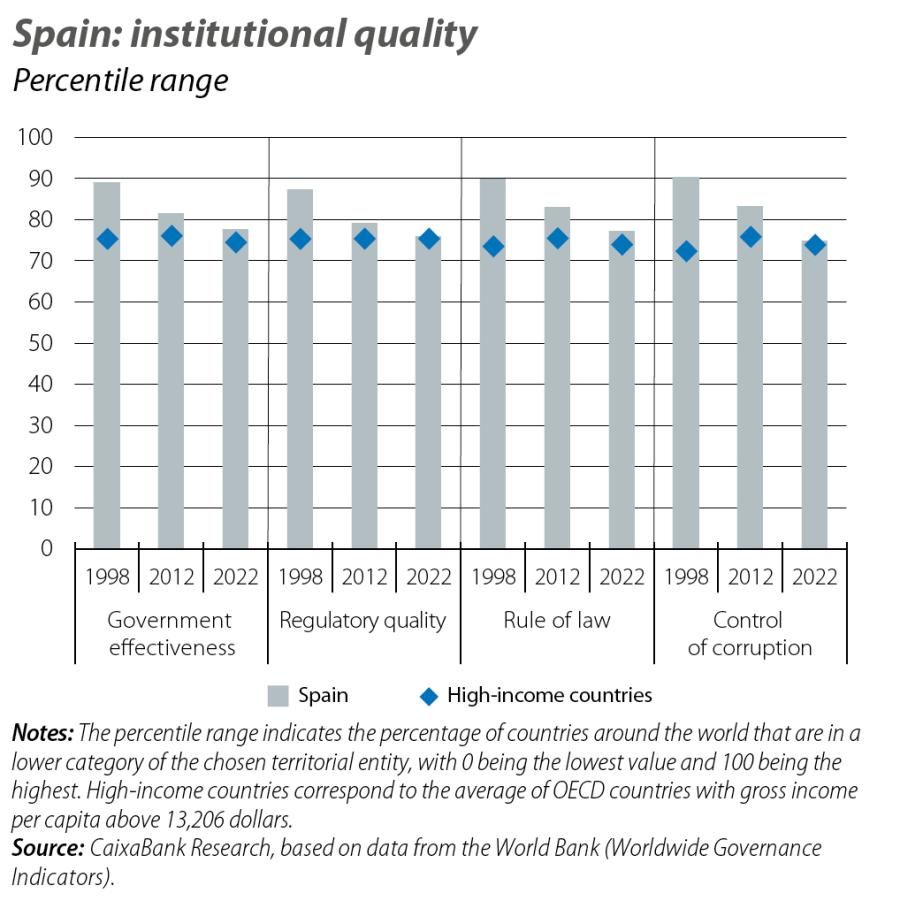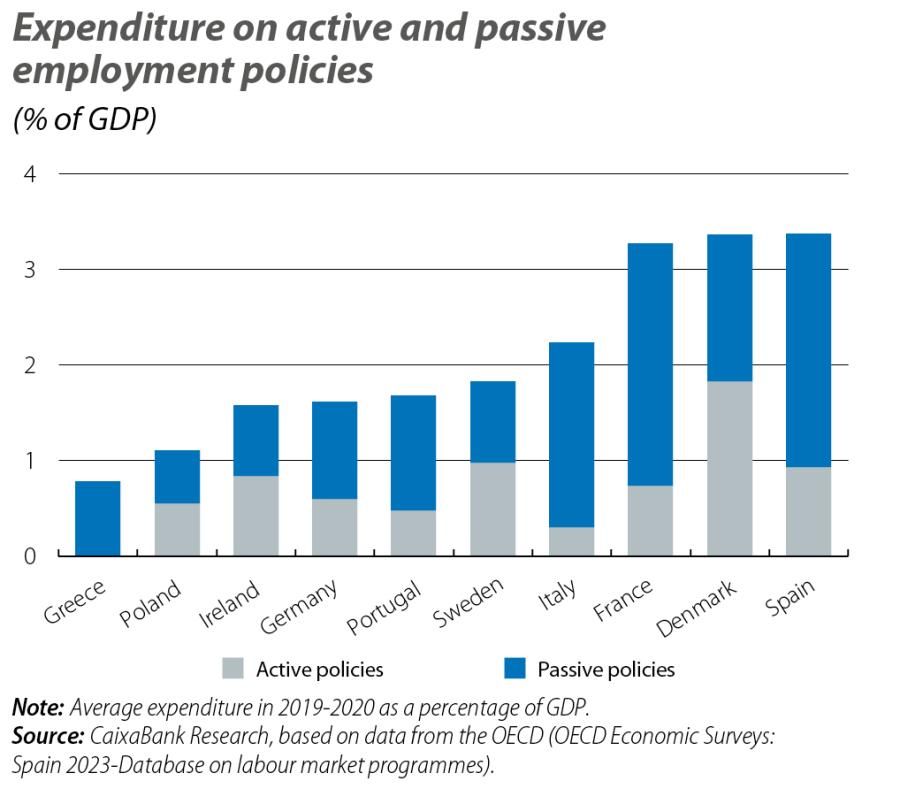How could structural unemployment be further reduced in Spain?
The Spanish economy continues to have the highest structural unemployment rate in the European Union, despite having managed to reduce it substantially in recent years. To curb it, improvements are needed on three fronts: greater supply and demand for employment and better matching between the two.

The ability that the Spanish economy has shown to substantially reduce structural unemployment in recent years has been quite remarkable. Until recently, it seemed impossible to bring it down so sharply without generating wage tensions. However, the structural unemployment rate (SUR), also known as the non-accelerating wage rate of unemployment (NAWRU),1 fell in Spain by 1.7 pps between 2018 and 2022 to reach 11.0%, according to AMECO estimates.2 Moreover, although all EU countries reduced their SUR following the post-pandemic employment boom, Spain, along with Portugal, Ireland and Poland, were the most outstanding pupils in the region, doing so at a faster rate, at around 0.5 pps per year on average (see first chart).
- 1. The SUR is the unemployment rate that is compatible with inflation close to the central bank’s target, which is why it is also known as the non-accelerating inflation rate of unemployment (NAIRU). The SUR is not directly observable and there are different methodologies for calculating it. For further details, see M. Romero and D. Fuentes (2017). «Tasa de paro estructural en la economía española: estimaciones, consecuencias y recomendaciones». Cuadernos de Información Económica, ISSN, 1132-9386.
- 2. According to the estimate from the Spanish government’s 2023-2026 Stability Plan, the SUR has been reduced by 2.2 pps between 2018 and 2022, reaching 10.3%.

Several factors have enabled the reduction in structural unemployment between 2018 and 2022. Firstly, job retention schemes (such as ERTE furlough schemes) prevented unemployment from sky-rocketing during the pandemic by allowing millions of workers to retain their jobs when activity ground to a halt. These programmes had been introduced in Spain with the 2012 labour reform to encourage internal flexibility for companies, making it feasible to temporarily reduce employment in the event of a drop in demand, and they were adapted to the exceptional circumstances triggered by COVID-19. After the pandemic, the strong boost to the economy after the resumption of activity favoured significant job creation in all developed economies, including Spain, which today has 1.4 million more registered workers than in 2019. Secondly, in the case of Spain the labour reform approved in 2022 has reduced the high temporary rate of the labour market by restricting temporary contracts, while at the same time increasing the flexibility available in permanent contracts, resulting in fewer people entering and leaving unemployment.3 This increased flexibility is mainly due to the wider use of permanent discontinuous contracts, which allow for hiring in a way that is adapted to the temporary nature of many occupations in Spain, such as tourism or agriculture, while providing workers with greater job stability.
Although Spain seems to be doing its homework, it is still the worst pupil in the EU: it has the highest structural unemployment rate in the region (11.0% in 2022, according to AMECO), ahead of the likes of Italy (9.2%) and Greece (9.4%). It should be recalled that a high structural unemployment rate implies an underutilisation of an economy’s productive capacity, as well as the exclusion of a large part of society from the labour market, so combating it is essential. To reduce it, improvements are needed on three fronts: increased demand for employment, increased job supply and better matching between the two.
The demand for employment from companies would increase with greater economic growth. The set of policies for increasing growth is wide-ranging and includes policies aimed at the green and digital transformations, as well as boosting competition in the markets for goods and services.4 The public sector could play a key role in all of them, as an impetus for structural reforms would allow for more rapid economic growth and greater buoyancy in the business sector. Although the last two labour reforms mentioned at the beginning are good examples, there is a need for greater momentum when it comes to reforms, as various institutions such as the European Commission, the OECD and the IMF have already recommended to Spain. In order to successfully implement structural reforms, a country must also have high-quality institutions,5 and this is an area where Spain has room for improvement in several regards (see second chart).
- 3. Although the «theoretical» (contractual) temporary employment rate has been reduced, in practice there is still a high rate of temporary employment, with short periods of employment and frequent changes in employment. See J.I. Conde-Ruiz et al. (2023). «Reforming Dual Labor Markets: “Empirical” or “Contractual” Temporary Rates?». Estudios sobre la Economía Española 2023/36, FEDEA.
- 4. For a comprehensive review of policies aimed at improving economic growth, see OECD (2023), «Going for Growth: Economic Policy Reforms 2023».
- 5. See K. Masuch, W. Modery, R. Setzer and N. Zorrell (2023). The euro area needs better structural policies to support income, employment and fairness. ECB Blog.

The supply of available employment can increase if the incentives for the unemployed to work are strengthened and if the training and employability of the population, including those not working at any given time, is improved. Various studies show that providing incentives for people to return to employment increases the likelihood of them doing so.6 The recent unemployment benefit reform is a partial step in this direction, as despite raising the amount of the benefit, it will gradually decrease as the months go by, and the subsidy can be received while undertaking paid employment for a period of 180 days. The key to the reform’s success will be the paths provided to help recipients of the subsidy seek and accept jobs. We must not lose sight of the fact that improving the training and employability of workers is another way to reduce unemployment. A clear example of this is vocational training, which is more closely linked to the demands of the labour market (thus providing greater protection against unemployment, as well as greater participation in the labour market throughout a person’s working life)7 but is less developed in Spain than in other countries, such as Germany.
Finally, a better match between supply and demand would make it possible to reduce structural unemployment. This dysfunction of the Spanish labour market is reflected in the growing number of unfilled vacancies, a phenomenon which coincides with a high unemployment rate, weighing down productivity and the full use of the economy’s productive capacity. This problem has been spreading and not only affects the most specialised profiles. Its causes are varied, ranging from economic and cultural barriers to geographical mobility and deficiencies in information on the availability of job positions. In this regard, active employment policies play an important role, since they support the unemployed in their search for employment and in their training in skills that are in demand. In Spain, however, spending on active employment policies is low, both in absolute terms and relative to passive policies (see third chart). Furthermore, only a small proportion of the unemployed find work through public employment services, so it would be useful to improve the efficiency of active policies,8 with a greater emphasis on offering job seekers personalised support (e.g. statistical profiling and predictive models for identifying job offers that fit the worker’s profile, etc.). This problem is not isolated to Spain: France, our neighbour, is putting great effort into bolstering services for supporting the unemployed. In its recent labour reform approved with the aim of achieving full employment,9 one of the key changes is that the unemployed are required to carry out at least 15 hours a week of activities dedicated to rejoining the labour market. On the other hand, the need for a better match between the demand and the supply of employment in Spain is also apparent in the high rate of over-qualification, which far exceeds that of our neighbouring countries.10
- 6. Á. Martínez Jorge (2023), «¿Qué sabemos sobre los efectos de modificar las prestaciones y los subsidios por desempleo en España?». EsadeEcPol Policy Reaction.
- 7. In this regard, see the analysis by CaixaBank Dualiza in its latest report on the state of professional training in Spain entitled «Informe 2023 - Observatorio de la Formación Profesional en España» (content available in Spanish).
- 8. See OECD (2023). «OECD Economic Surveys: Spain 2023». OECD Publishing, Paris.
- 9. See Loi du 18 décembre 2023 pour le plein emploi.
- 10. For more information on over-qualification in Spain, see the Focus «Changes in the educational level of Spanish workers» in this same Monthly Report.

As we have seen, reducing structural unemployment is not an easy task and it needs to be tackled from several different angles. Moving the economy towards full employment is a goal that should generate consensus and which would entail significant social improvements, as it would reduce the exclusion from the labour market of a large part of society.



